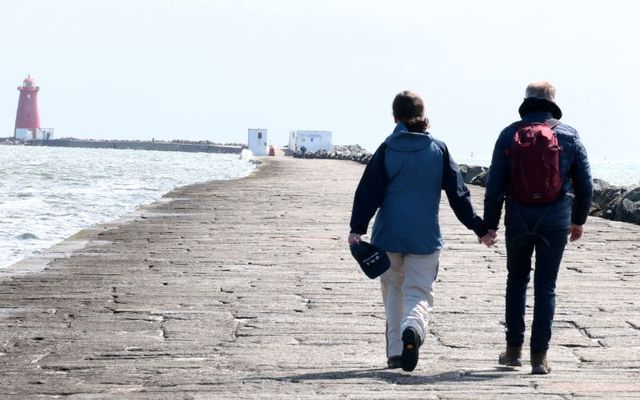Summer 2024 was the coldest in Ireland in nine years, since summer 2015, when the average national temperature was 13.87 °C, Met Éireann said in its climate statement Wednesday, September 4.
Overall, the average national temperature in Ireland for summer 2024 was 14.50 °C, which is 0.28 °C below the most recent 1991-2020 long-term average (LTA) and 0.19 °C below the 1981-2010 LTA.
However, the average national temperature for summer 2024 is 0.25 °C above the 1961-1990 LTA.
Summer 2024 was the coldest since 2015 and the first cooler-than-average season since spring 2021 (averages compared to the periods from 1981-2010 and 1991-2020). ?
Check out the full climate statement for summer 2024 ?? https://t.co/4HJ8qXiD7h https://t.co/zMhZxpC09s
— Met Éireann (@MetEireann) September 4, 2024
Met Éireann said on Wednesday that summer 2024 in Ireland "was cool and relatively dry overall."
The Irish National Meteorological Service reported: "Several arctic blasts from the north in early June set the scene for what turned out to be the first cooler than average season since spring 2021 (13 seasons ago).
"A zonal jet stream (west to east), directly over or close to Ireland for most of the season, blocked warm air masses to the south from pushing north over Ireland.
"On the few occasions when the jet stream became more meridional (north to south), such as in early June and early July, its orientation favoured high pressure building north over the mid-Atlantic, which allowed cool Polar maritime air masses to move in over Ireland from the north or northwest."
Met Éireann continued: "June and July were dry and cool months.
"A northerly airflow from the Arctic dominated the first half of the June, while Atlantic westerlies took control for the second half of the month.
"July saw a cool north-westerly for the first third of the month followed by a gradual warming as high pressure to the west moved east.
"The final third of the month began with low pressure to the north in control before high pressure built to the south.
"August saw low pressure to the north and northwest and high pressure to the south and southeast for most of the month. This setup brought the bulk of the rainfall to the West and Northwest of the country and kept these regions cool, while the South and East experienced a drier and warmer month."
Overall, the Northwest of Ireland was wet while the Midlands, South, and East were dry during the summer of 2024.
The season’s wettest day was recorded at Newport, Co Mayo with 34.6 mm on Sunday, August 4, Met Éireann said.
The number of rain days - days when 0.2 mm or more of rainfall is measured -ranged from 43 days at Roche’s Point in Co Cork to 73 days at Knock Airport in Co Mayo.
The number of wet days - days with 10.0 mm or more of rainfall - ranged from 25 days at Oak Park in Co Carlow to 57 days at Newport in Co Mayo.
The number of very wet days - days with 10.0 mm or more of rainfall - ranged from zero days at Moore Park in Co Cork to 18 days at Newport in Co Mayo.
Meanwhile, Ireland had below-average temperatures nearly everywhere throughout summer 2024, with the northwest the coolest.
The highest temperature of summer 2024 was reported at Phoenix Park in Co Dublin on Monday, June 24, with a temperature of 26.6 °C. This was the lowest maximum summer temperature for Ireland since 2015.
The season’s lowest minimum air temperature was recorded on Wednesday, June 12 at Claremorris in Co Mayo with 1.8 °C, while the lowest grass minimum was -1.4 °C, reported at Mullingar in Co Westmeath on Tuesday, June 11.
There was no air frost reported this season and less than half of stations reported ground frost. The number of days with ground frost ranged from zero days at a few stations to five days at Mullingar in Co Westmeath.
Most stations had their coldest summer since 2015.
The eastern part of Ireland was the sunniest during the summer of 2024.
The highest number of daily sunshine hours recorded this season was 15.9 hours at Gurteen in Co Tipperary on Wednesday, June 19.
The number of dull days - days with less than 0.5 hours of sunshine - ranged from six days at Casement Aerodrome in Co Dublin to 17 days at both Valentia Observatory in Co Kerry and Belmullet in Co Mayo.
Gales were reported on one day in June and five days in August, including during Storm Lilian.
The number of days with gale force winds ranged from zero days at most stations to three days at Roche’s Point in Co Cork.
There were no strong gales or storm-force winds reported this season.
The season’s highest 10-minute mean wind speed of 37 knots (68 km/h) was reported at Mace Head in Co Galway on Thursday, June 27, Belmullet in Co Mayo on Wednesday, August 21, and Roche’s Point in Co Cork on Friday, August 23 during Storm Lilian.
The highest gust was 52 knots (96 km/h) reported at Roche’s Point in Co Cork on Friday, August 23 during Storm Lilian.




Comments